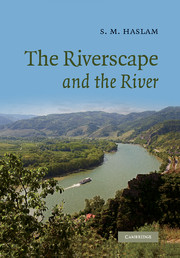Book contents
- Frontmatter
- Contents
- List of tables
- Preface
- Acknowledgements
- 1 Introduction
- 2 The natural river and its destruction
- 3 The natural riverscape and its modification
- 4 Resources I. Water resources and their loss
- 5 Development and variation of rivers
- 6 Development and variation of riverscapes
- 7 Building blocks of river vegetation
- 8 Building blocks of flood plain vegetation
- 9 Resources II. Plants and animals, cleaning and minerals
- 10 Building blocks of the riverscape
- 11 Patterns, boundaries and fragmentation
- 12 Resources III. Settlements and constructions
- 13 The harsh riverscape
- 14 The tempered or smiling riverscape
- 15 Envoi
- Bibliography
- Index to plant and animal vernacular and taxonomic names
- General subject index
3 - The natural riverscape and its modification
Published online by Cambridge University Press: 10 August 2009
- Frontmatter
- Contents
- List of tables
- Preface
- Acknowledgements
- 1 Introduction
- 2 The natural river and its destruction
- 3 The natural riverscape and its modification
- 4 Resources I. Water resources and their loss
- 5 Development and variation of rivers
- 6 Development and variation of riverscapes
- 7 Building blocks of river vegetation
- 8 Building blocks of flood plain vegetation
- 9 Resources II. Plants and animals, cleaning and minerals
- 10 Building blocks of the riverscape
- 11 Patterns, boundaries and fragmentation
- 12 Resources III. Settlements and constructions
- 13 The harsh riverscape
- 14 The tempered or smiling riverscape
- 15 Envoi
- Bibliography
- Index to plant and animal vernacular and taxonomic names
- General subject index
Summary
Every landscape settled by Man becomes a blend of the natural and the human. It is a fabric made by man.
(Williams, 1970)Neither war nor earthquake are as destructive of history and culture as too much money
(Rackham, 1986)Landscape is the basis of human environment … the place of many processes influencing life.
(Vink, 1983)Introduction
Chapter 2 discussed the natural river and its destruction. Many streams have been totally destroyed in the past c.150 years (dried and gone) and more have been destroyed ecologically, having an inadequate, or almost gone, biota. Since the riverscape is needed for people to live on and grow their food on, it is seldom destroyed (by, e.g. quarrying it away), but is instead modified. While water is the medium of the river, the riverscape is mostly in the mediums of air and soil, with water a small, though essential component. However, it is the river (or glacier) that has made the riverscape! And it is the river which makes (or made) its pattern, with its network flowing downstream.
In the long term, the river moves the riverscape to the sea, but this time-scale need not be considered here. The river does, though, move water, energy, sediment, nutrients, debris, pollutants and biota. All move downstream, except for animals with independent mobility, and plants moved by animals or wind.
A riverscape, being so much larger than a river, has even more complex influences.
- Type
- Chapter
- Information
- The Riverscape and the River , pp. 53 - 85Publisher: Cambridge University PressPrint publication year: 2008



